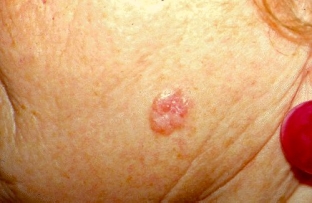Basal cell carcinoma is one of the malignant skin tumors. A distinctive feature of basalioma is its slow development (in some cases up to 10-15 years) and the predominant absence of metastases. That is why in the early stages such skin cancer responds well to treatment. However, due to the characteristic features of this disease and the slow course, patients often turn to an oncologist late, which greatly complicates the treatment of basalioma with minimal aesthetic consequences for the patient. And since basal cell carcinoma most often affects the scalp and neck, the aesthetic aspect of the removal of this neoplasm plays a significant role.
General information about basaliomas: symptoms and risk factors
Basaliomas develop from the cells of the basal layer of the epidermis and occupy an intermediate position among malignant neoplasms of the skin, since they do not give metastases, although they differ in locally destructive growth.
Basal cell carcinoma is localized mainly on the face, namely:
- in the area of nasolabial folds;
- on the wings of the nose;
- on the upper lip;
- at the temples;
- on eyelids;
- on the outer and inner corners of the eyes.
We'll look at:
- symptoms of basalioma;
- risk factors in the development of basalioma;
- methods of removal of basalioma.
Symptoms of basaliomas: how to determine the presence of a malignant neoplasm
Most often, basalioma appears as a single node. The neoplasm is painted in a pale pink, flesh or reddish color and is not initially accompanied by painful sensations, so the patient may take this type of skin cancer for a harmless pimple. However, over time, the pimple does not go away: it can ulcerate, followed by the appearance of a vascular network and a compacted crust on the surface. Bleeding and further deepening of the ulcer indicates the development of basalioma and its damage to surrounding tissues.
Because a basalioma can take many forms, it is best to see a doctor if any suspicious skin growth appears.
In the case of a cicatricial-atrophic form of basalioma, the growth of the neoplasm is observed along the edges and its scarring in the center of the ulcer.
Perforating basalioma is much less common, but develops faster and differs in signs from the nodular-ulcerative form.
Varty basalioma consists of dense hemisphere-shaped nodules that protrude noticeably above the surface of the skin.

Risk factors in the development of basalioma: who is at risk
Doctors say that basalioma, like other types of skin cancer, most often appears as a result of too long and frequent exposure to sunlight. Statistics show that it is this type of skin cancer that in 70% of cases is detected by oncologists.
In addition to sun exposure, two important risk factors are skin color and patient age. Most often, the disease affects fair-skinned people over the age of 50 years. In addition, the risk of developing basalioma increases due to the following factors:
- contact with toxic substances;
- contact with carcinogens;
- frequent skin injuries;
- burns and scars;
- exposure to ionizing radiation.
Basalioma removal: available methods and their effectiveness
Choosing a method for removing basalioma – task of a qualified specialist. After carrying out all the necessary diagnostic measures (examination, palpation, cytological and histological examination, ultrasound, laboratory tests), the doctor, taking into account the location, degree of development, clinical form and morphological appearance of the basalioma, may choose one of the following methods for removing the neoplasm:
- surgical intervention;
- cryolysis;
- radiotherapy;
- local chemotherapy;
- laser removal;
- combined method.
Diagnosis and treatment of basalioma – task of a qualified specialist. Self-treatment is excluded.
If the tumor is in the early stages of development and is small in size, laser removal of the basalioma, which is successfully performed by the specialists of the Clinical Academy of Laser Medicine (CALM), will provide:
- effective treatment method;
- maximum security;
- minimal discomfort during the procedure;
- positive medical and aesthetic result.
Remember that in 95-98% of cases, removal of a basalioma in the initial stages, until the tumor has invaded the underlying tissues, provides a lasting cure. However, an important factor in this case is timely diagnosis and well-chosen treatment, so any suspicious skin growths must be shown to a qualified specialist.






Add a comment